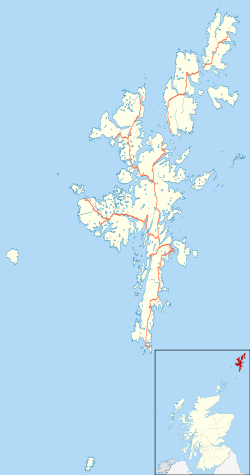| Gossabrough | |
|---|---|
 Sheep at Gossabrough, with a ruined haa in the background | |
Location within Shetland | |
| OS grid reference | HU525831 |
| Civil parish | |
| Council area | |
| Lieutenancy area | |
| Country | Scotland |
| Sovereign state | United Kingdom |
| Post town | SHETLAND |
| Postcode district | ZE2 |
| Dialling code | 01957 |
| Police | Scotland |
| Fire | Scottish |
| Ambulance | Scottish |
| UK Parliament | |
| Scottish Parliament | |
Gossabrough is a coastal hamlet, wick and ness on the southeast side of the island of Yell, Shetland, Scotland. The Wick of Gossabrough lies between the northern extremity of Gossabrough Ness and the Saddle of Swarister. [1] The hamlet is accessed via the B9081 road. The Loch of Hudon lies just to the southwest.


